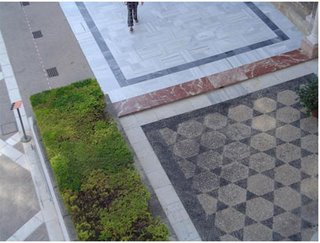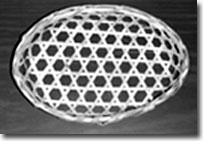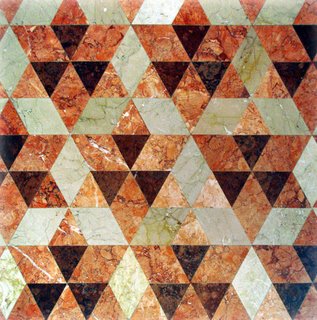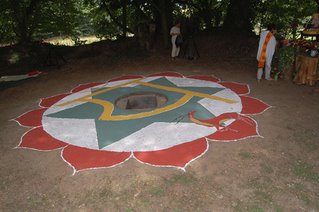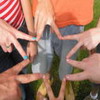I thank Oren Mass for giving me Andre Neher’s Hebrew book, David Ganz (1541-1613) and his times, Jewish thought and the science revolution of the sixteenth century, Rubin Mass Ltd, Jerusalem, 1982.
Andre Neher mentions on p. 115 that the tombstone of the Jewish scientist David Ganz was the first Jewish tombstone, which carried on it the Star of David symbol (my translation, zeevveez):
Tombstone of David Ganz
Source:
Jewish Encyclopedia - 1906 Entry: GANS, EDUARD
Only after one Hundred year, in 1726, we find again this sign on a tombstone, this time in Bordeaux, and again in 1736 in Prague…on the grave of rabbi David Openheimer…at the end of the eighteenth century the emblem became more common. In the 20'th century, after two world wars reaped blood harvest of millions of people, the Magen David becomes prevalent in military graveyards as a mark of the grave of a Jewish combatant who fell for the sake of his homeland, alongside a cross that waves on his Christian colleague, on a crescent that waves on the grave of his Moslem colleague.
Note (zeevveez): There was a Magen David on the grave of David Milo in Tarent, Italy already in the 3 century C.E. so that Gans’ tombstone is the second that has a Magen David engraved on it.
The main reason that a Magen David waves on the grave of David Gans according to Neher is the title for Gans’ astronomy book, Magen David
In is a known fact that the hexagram which was called by the Arabs Solomon’s Seal, was called by the Jews in the Middle Ages the Star of David. From the 12th century to the 18th century this emblem appears in hundreds of documents, Jewish and non-Jewish, all of them in the field of practical Kabala and fortune telling (See: Abraham Yaari, Hebrew, Jewish Printers, Jerusalem, 1943) and there is no exception but David Gans’ Magen David book. One of the reasons he gave this title to his book was his first name, but at the same time he removed the mystery from the essence of this emblem. According to our knowledge he was the first in doing so, and we find here again the typical trait of his general attitude toward science. The Star of David for him is not some magical formula but a geometric formula. The Star of David is not a witchcraft tool, but the excellent emblem of astronomy.
Andre Neher quotes from Gans’ Magen David book:
When two triangles are drawn one on top of the other, people of our generation use to call it Star of David, saying that a drawing like this was engraved on King David’s shield, and because the main element of measurement is the measurement of the triangles.
Andre Neher comments:
In David gans’ period this emblem still didn’t had a symbolic national wide significance, and the opinion that the origin of this significance was in Prague seems right. The Jewish community of Prague was the only community that received in 1354 from King Karl the 4th the right to hoist a flag, which carried the Star of David. [See photo above] Then, of course, it had only the quality of a local emblem, without any significance to the Jewish people as a whole. The people generally accepted this emblem only after the eighteenth century, and only the Zionist national aspiration at the end of the 19th century made the Magen David a general symbol of Israel.
The following paragraph is from Dr. Asher Eder’s book The Star of David, which was published in 1987 in English in Jerusalem by Rubin Mass Ltd. The publication here is courtesy of Oren Mass
This version includes corrections and new materials that do not appear on the printed version
Another synagogue of the Byzantine period, at Eshtamoa in the territory of Judea, also shows this star. Drawn in curved lines somewhat similar to [the one found in Capernaum] it decorates the lintel of the entrance gate.
Marut Synagogue mosaic
Marut Synagogue was built from the fourth century CE until the seventh century. The excavations revealed a mosaic floor, dated to the sixth century.
Photo by archaeologist Zvi Ilan © who wrote in the description of the excavations that Professor Yigal Yadin suggested that the image of a young man near sword, helmet and Scuta shield (Hebrew: Magen) is the image of David Ben-Yishai with Goliath's weapons
Image from Hebrew Wikipedia entry
Marut Synagogue
Professor Yadin's proposal implies that in the sixth century CE there was a visual "connection" between the shield (Magen) and King David, even though the shape of the Jewish star is missing in this mosaic
The ruins of the synagogue of Marut in Upper Galilee, dated as late as the eighth century, shows the biggest example found so far of this star. These data being correct, it would mean that synagogues could still be built in the Arab period, and that their designs can be determined from the remains.
The fact that this star appears several times in these ruins [of Caprnaum] might suggest that it played a special role in the thinking of the Jewish community of that time. But the existence of many other symbols next to it prevents us from seeing it as a specifically Jewish symbol. We can only conclude that it was acceptable to Jewish thought.
Also, the use of this symbol by communities outside the Land of Israel does not change this picture. Even a seventh-century tombstone in Taronto, South Italy, above the grave of the wife of Leon, son of David, which has a hexagram chiseled in front on the name David, is no proof to the contrary; nor do other tombstones of the early and later Middle Ages, which link the hexagram to the name David. A very picturesque example of such a linkage is a tombstone of a German Rabbi of the 17th Century. His name was David Gans, the word Gans meaning goose. A carving on his tombstone shows the bird on top of a hexagram, the latter may stand for David, or it may refer to his last work, Magen David.
David's star (Magen David) on the tombstones of the old Jewish cemetery in Prague Judaica Bohemiae, vol. 27(1991), nr. 1-2, p. 79-82:
The author has found in the cenetery altogether 17 tombstones with the David's star...in three cases, including the oldest tombstone from 1529 the name of Menahem or Mendl...It was assumed that the oldest David's star was on David Ganz tombstone from 1613 ...the name menahem is another name for the Messiah. It can be concluded that the undercurrent of this use was messianist meaning of this symbol' its connection with the expected arrival of the Messiah Ben David.
 Red Jewish Star appears on a stained glass window of the Askenazi Synagogue in Istanbul, which was constructed by Jews of Austrian origin.
Red Jewish Star appears on a stained glass window of the Askenazi Synagogue in Istanbul, which was constructed by Jews of Austrian origin.
